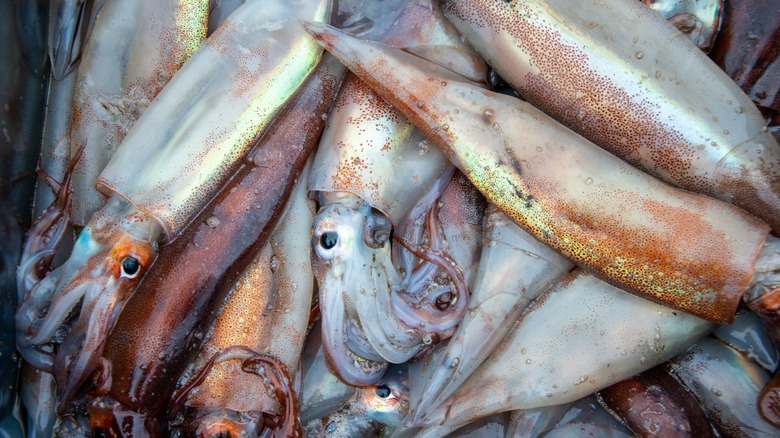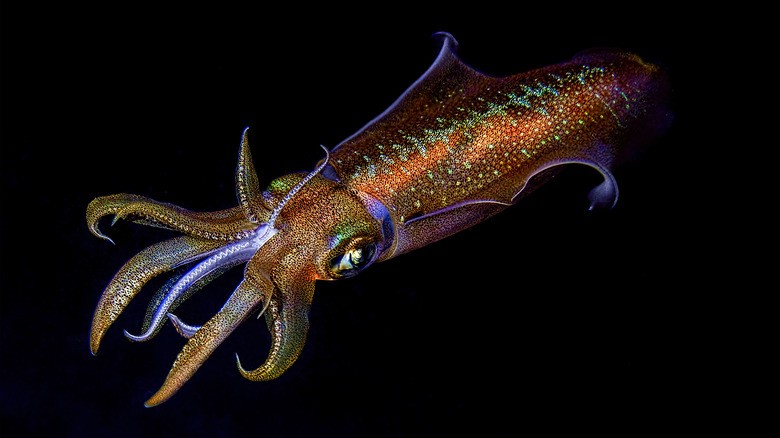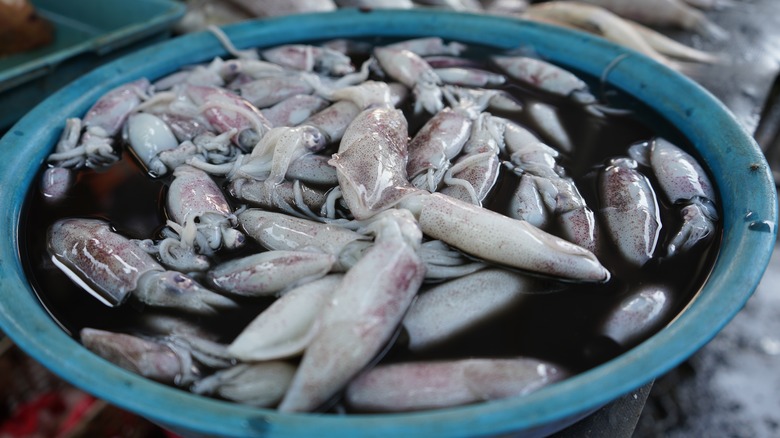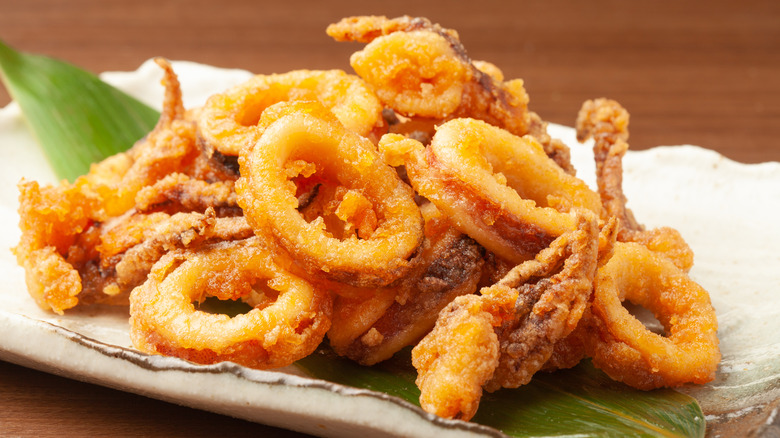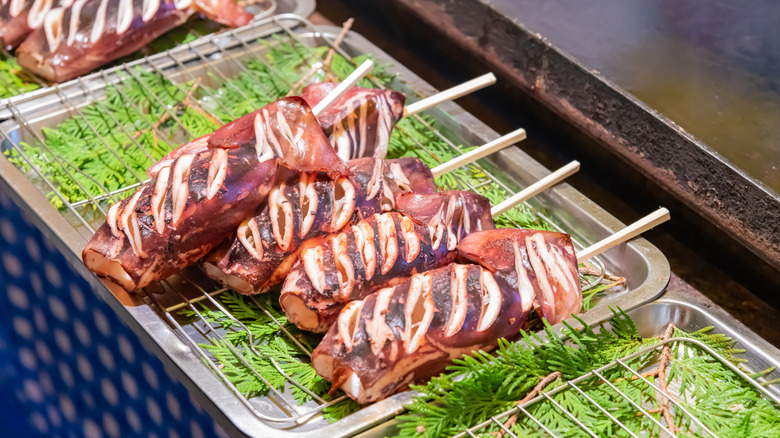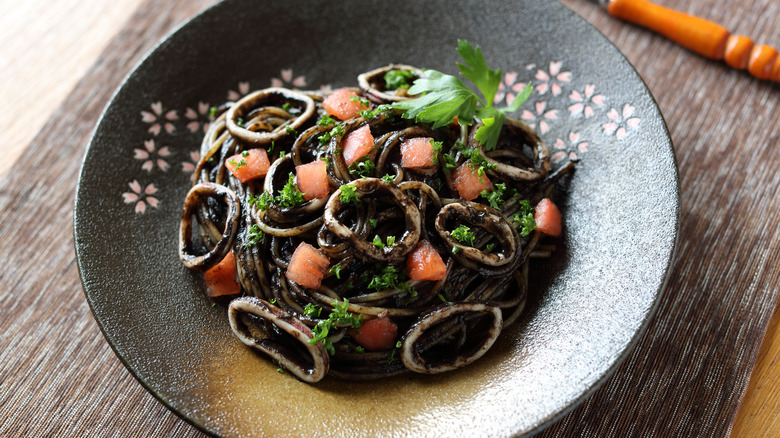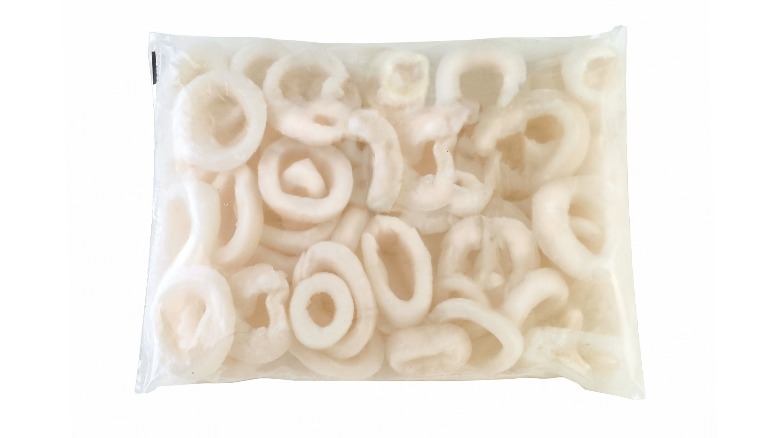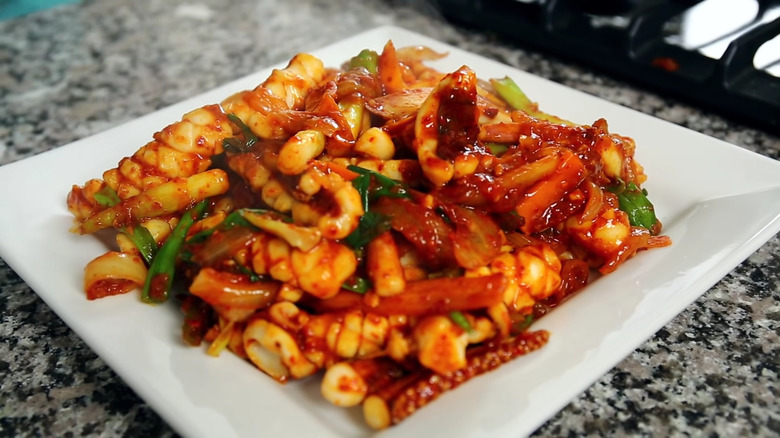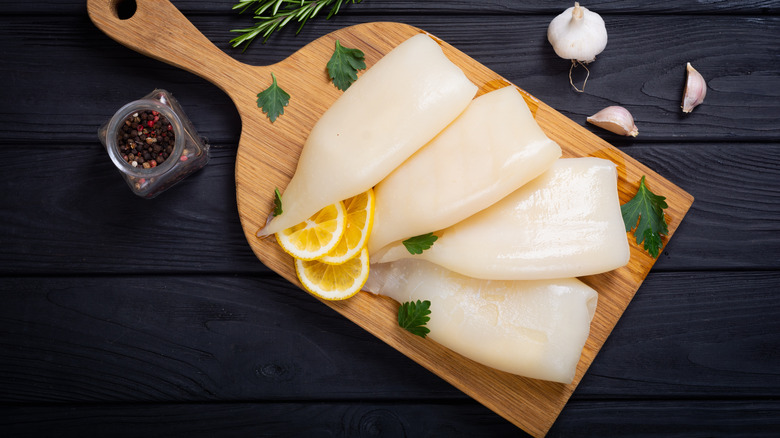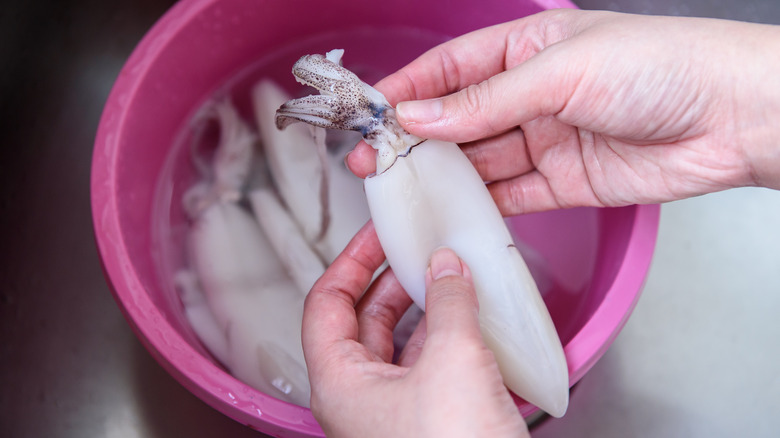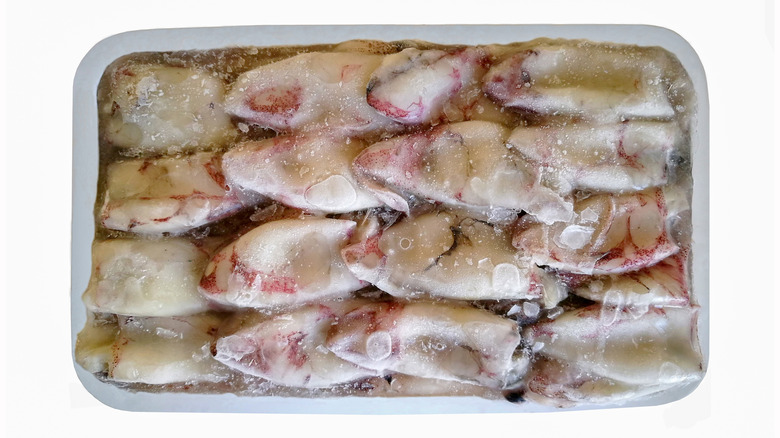The Ultimate Guide To Calamari
Squid are known to be intelligent animals. Studies have revealed not only their problem-solving and memory retention abilities but also their mischievous nature. BBC Science Focus reports a whole host of cheeky actions, including cephalopods learning to turn off lights by firing water at switches, binning substandard food, and even squirting water at people they don't like.
From a gastronomic perspective, squid — under the name of calamari — generally means one thing to most people: deep-fried rings that are served as appetizers in restaurants around the world. However, contrary to common belief, the term calamari does not refer to this specific dish, but to all squid that is served as food (via Merriam-Webster).
The anatomy of a squid can generally be broken down into three parts — numerous arms and tentacles, a small head, and a long tubular body — and the size can vary dramatically from one species to another, per Britannica. Only the body, arms, and tentacles are widely consumed across the globe, and they are prepared and eaten in a variety of ways. When it comes to calamari, there is so much more than the same old rings of battered and fried squid.
There are numerous species of squid all over the world
Squids are a type of mollusk that belong to a class called cephalopods, which also includes octopus and cuttlefish. As Smithsonian Ocean highlights, cephalopods have been incredibly successful at adapting and surviving for around 500 million years. There are now more than 300 squid species around the world, per National Geographic.
Despite this diversity, we tend to only consume a few squid species. According to The Guardian, these include Atlantic squid, Japanese Flying squid, Humboldt squid, Argentine short fin, and Indian squid. The reasons why we consume these squids and not others are due to several factors, including abundance, location, and size. However, some larger, deep-dwelling squid, such as the famed Giant squid, are not consumed for the simple fact that they are inedible. In an interview with The Guardian, fishmonger Steve Hatt explains, "The giant squid is poisonous, so you can't eat it. It has a high ammonia content – it's a totally different species to the squid that live nearer the surface."
The origins of calamari consumption are ancient
While many Americans think of calamari as a relatively new food that was popularized in the 80s, squid has actually been consumed for millennia (via The New York Times). As reported in Frontiers of Communication, archaeological evidence indicates that ancient Egyptians, Greeks, Romans, and Hawaiians all caught and ate squid.
One highly popular ancient use of squid was to make garum, which is a condiment made from putrefied seafood that was widely consumed across ancient Europe, per Murcia Today. One of the societies to most notably champion garum was the Roman Empire, where differing standards of the condiment were made available for all levels of society. This was explained by Claudio Giardino, a professor of prehistory and protohistory at the University of Salento, in an interview with NPR. "According [to] the Roman writers, a good bottle of garum could cost something like $500 today," he explained. "But you can also have garum for slaves that is extremely cheap. So it is exactly like wine."
Ancient Romans also used calamari in numerous dishes, as highlighted by passages in the 5th-century cookbook "Apicius," (via Project Gutenberg). Dishes ranged in style and included such recipes as calamari braised in wine, as well as a version that is stuffed with boiled brains, eggs, and spices.
Fried calamari is a popular appetizer
As reported by The New York Times in 1996, the rise of fried calamari was initiated by Cornell Cooperative Extension. The group promoted the culinary uses of squid to alleviate the pressure on more commonly-eaten fish species, such as cod and flounder.
Most American restaurants decided that battering and frying the squid and serving it with a dipping sauce would make it more appetizing to skeptical guests, per Salon. To boost sales, Cornell Cooperative Extension advised restaurants to market the squid under its Italian name, calamari. Thus, the dish as we now know it was created.
Since the Cornell Cooperative Extension began promoting the fishing of squid in the 80s, the popularity of fried calamari has risen and fallen over time. The New York Times reports the use of the term "fried calamari" in the publication peaked in 1996. While this is by no means an exact way of measuring the dish's popularity, the common consensus is that fried calamari has lost some of its allure, and is now seen as a run-of-the-mill appetizer, predominantly served at middling bars and restaurants.
The Japanese are huge consumers of calamari
While calamari has only become popular in the United States during the last 40 years or so, the citizens of Japan have long had an appetite for it. This love for calamari has consistently led to the country ranking as one of the biggest importers of squid globally, per Renub Research. So, it is somewhat unsurprising that Japanese cuisine offers multiple means of cooking calamari, the most famous of these being Katsu ika odori don.
BBC reports that katsu ika odori don is a dish of fresh calamari served on top of noodles and roe with soy sauce poured over it. As the soy sauce comes into contact with the squid its tentacles curl and twitch as if it was still alive. This display has brought the dish to a level of digital notoriety. However, you can rest assured that the squid is in fact dead; it is merely the sodium in the soy sauce that causes the squid's nerves to fire.
Another Japanese, calamari-based delicacy — albeit a more regional one — is ikayaki. According to Osaka.com, ikayaki is a whole, grilled squid that has a soy sauce glaze and is usually served on a skewer. It is commonly eaten as street food and has long been associated with the Kansai region of Japan.
Squid ink is popular in Japan and the Mediterranean
While it is the squid's body and tentacles that are most frequently eaten, the animal's ink is also a global delicacy. As The Guardian reports, squid ink is harvested from the dead animals by carefully removing the ink sac. The ink is strained and sterilized before being stored, packaged, or sold (via Sous Chef). As reported in Marine Drugs, the ink of all cephalopods is rich in glutamic acid, the compound responsible for umami, per Flavour.
In Japan, squid ink has remained popular throughout history thanks to its supposed medicinal properties. Ikasumi jiru — squid ink soup — was eaten in the Ryukyu Kingdom and remained an integral part of the culture even after the kingdom was dissolved by Japan and renamed Okinawa (via Okinawa Prefecture). For the more fast food-minded Japanese citizens, squid ink has also gained notoriety by being served in McDonald's. The fast food chain introduced a black, squid ink burger in 2014.
There are concerns over the sustainability of eating squid
As we have seen, squid was popularized in the U.S. in an attempt to take the pressure off other, overexploited marine species. However, the volume and means by which squid have been caught in recent years have led many to raise alarms over the sustainability of squid fishing.
Many of the fishing vessels use methods that damage the natural environment. For example, The Guardian reports that Atlantic squid, the most popular species in the United Kingdom, is predominantly caught using a trawling method that damages habitats and results in a lot of bycatch, per Sustain. Furthermore, the massive increase in calamari demand has seen the squid fishing industry grow rapidly. According to Greenpeace, certain squid fishing sights have seen an 800% increase in fishing activity since 2017.
Fortunately for Americans, one of the species fished on the east coast — the Longfin squid — is currently not overfished despite 23.4 million pounds being caught in 2021 alone. In fact, the population is actually in excess of its target (via NOAA Fisheries). What makes Longfin fishing even more sustainable is the fact that the muddy sea floor in these areas sustains less damage from trawling, although bycatch still remains a pertinent issue.
The majority of calamari consumed in America is imported
While squid fishing in the waters around America may be deemed by some as sustainable, what occurs with the catch afterward is less so. This is because, as reported by NPR, 80% of squid caught in the United States is sent to China. In an interview with the outlet, Emily Tripp, the founder of Marine Science Today, explained, "Squid is a labor-intensive product. It's cheaper in some situations to ship it to China to be processed and ship it back." However, the vast majority of this catch is never returned.
On average, only 1.4% of the squid caught in American waters and sent to China makes it back to the U.S. Why? Because Americans generally prefer to eat bigger squid, as Diane Pleschner-Steele, executive director of the non-profit California Wetfish Producers Association, explains. "It has to do with the American desire for a larger squid," she said. "A lot of squid that is shipped overseas stays overseas because they prefer it...Our consumers typically prefer a larger squid, and so there's just a ton of squid imported into this country that comes in at a far lower price."
Calamari is featured in many cuisines
Aside from Japanese and Mediterranean cuisines, calamari is also featured in many other global cuisines. For example, squid is a very popular form of Korean anju, or food eaten with alcohol, per the Los Angeles Times. Frequently the calamari is eaten dried; however, it is also popular when fried and mixed with gochujang in a dish called oh jing uh bokkeum.
Ghanaian cuisine also features calamari, which should come as little surprise given the country's waters are so abundant (via Time Out). Along with other seafood, squid is sometimes used to make shito, a hot sauce that is integral to the country's cuisine. In an interview with The Splendid Table, cookbook author Zoe Adjonyoh explained, "I remember being at Jamestown watching a haul come in, and I couldn't believe the variety. There was even squid and stuff like that[...]That smoked, dried, salted fish flavor [...] it's one of the key features of a hot pepper sauce I love that is kind of an accompaniment to pretty much every meal."
Calamari has many health benefits
As reported by Livestrong, calamari can be part of a healthy diet because it's high in protein and low in calories. According to the U.S. Department of Agriculture, calamari has 90 kilocalories per 100-gram serving, along with 16 grams of protein and 1.5 grams of total fats. Calamari is also high in vitamins B12 and B6 and selenium (via the Shellfish Association of Great Britain). What's more, calamari also contains omega-3 fatty acids.
The omega-3 fatty acids found in calamari have a high concentration of docosahexaenoic acid (DHA). DHA-rich omega-3 fatty acids have been shown to reduce the resting heart rate of individuals who previously suffered from heart attacks, suggesting that they protect the heart by reducing its workload, per Critical Reviews in Food Science and Nutrition. Speaking to the Daily Mail, nutritionist Suzie Sawyer highlighted some additional key benefits of DHA-rich omega-3 fatty acids. "DHA is the predominant omega-3 in many of our vital organs and is fundamental for our health," she explained. "DHA is important for brain health, improving concentration, memory, and cognitive development. It is critical in the maintenance of overall eye health and research indicates it can help to improve blood pressure and may reduce the risk of heart disease."
Calamari is easy to prepare and cook
With its long body, small head, and mass of arms and tentacles, squid can be an intimidating animal to prepare and cook for the first time. However, cleaning a squid is not as complicated as you might think. According to MasterClass, separating the head from the body is as simple as pulling the two in opposite directions. The mass of cartilage present inside the squid's body can also be easily removed by hand while the tentacles and arms can simply be sliced from the head and washed.
Great British Chefs reports that, when it comes to cooking calamari, there are two schools of thought: Cook it at a high temperature for a short period, or at a low temperature for a long period. This is because any middle ground will likely destroy the calamari's texture and make it unpleasantly tough. But aside from following this rule, the world is your oyster, as highlighted by Australian chef James Maffescioni in an interview with ABC Everyday. "It works with a range of different flavors — sweet, sour, chili, spicy, salty," he explained. "You can bake it, you can sear it, you can deep fry it, you can cure it."
Freezing calamari is not a bad thing
Freezing calamari not only allows the delicate meat to avoid damage and spoiling during transportation, but it also provides several other benefits, per the Ministry of Foreign Affairs. First of all, freezing the squid kills any parasites that may be present within the meat, making it suitable for raw consumption. Of course, this is vital in countries, such as Japan, that utilize raw calamari heavily, most notably in the form of sushi (via Frontiers in Communication).
Even calamari that is going to be cooked can benefit from freezing. Despite BBC Good Food stating that freezing has no effect on squid, a study published in the Journal of Home Economics Japan begs to differ. The Journal notes that freezing squid at approximately minus .4 degrees Fahrenheit — the average home freezer temperature — and subsequently thawing it, softened the meat of the squid. This is due to the formation of ice crystals that break down tissues, which may help negate the tough, chewy texture that accompanies poorly cooked calamari.
